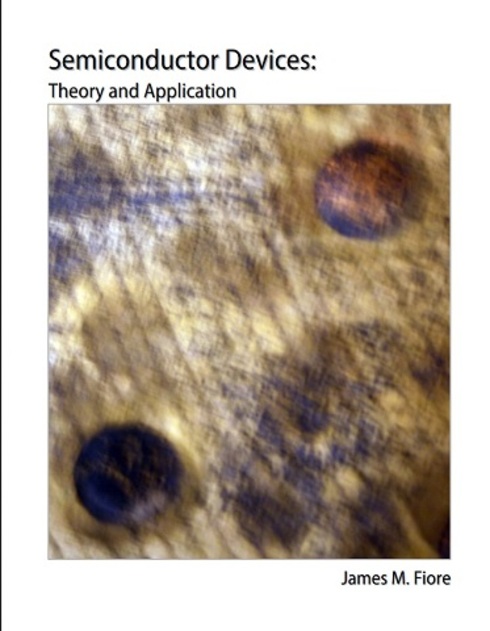










This book discusses the features and applications of the fundamental semiconductor devices such as diodes, bipolar junction transistors, junction field effect transistors, metal oxide semiconductor field effect transistors, and insulated gate. read more





Reviewed by Yang Zhao, Assistant Professor, Taylor University on 12/16/21, updated 12/23/21
Comprehensiveness rating: 5 see less
This book discusses the features and applications of the fundamental semiconductor devices such as diodes, bipolar junction transistors, junction field effect transistors, metal oxide semiconductor field effect transistors, and insulated gate bipolar transistors. These are the basic devices that are used in industry and they should be covered in an introductory semiconductor or electronic course.
Content Accuracy rating: 4
The features and applications of the semiconductor devices are descripted accurately by the text, the equations, and the graphics in this book.
Some web links are included in this book for the readers to explore the details of some content. However, these links might be removed any time. For example, the link to the datasheet of 1N4148 is invalid now (as December 2021).
Relevance/Longevity rating: 4
The semiconductor devices that are discussed in this book are the popular ones in industry. They are not likely to be discarded in the near future.
The example semiconductor devices might be discontinued by the manufacturers, as the new models will replace the old ones.
Clarity rating: 5
This book introduces the basic concepts with clear definitions and terminologies. It explains the theory and models with mathematical equations and figures. It demonstrates the applications with example problems and computer simulation results.
Consistency rating: 5
Some variable names are listed in Chapter 1 and they are used through the book. The parameter names, their units, and their typical values are listed under some of the equations. The terminologies in this book are the common ones that are used in other books and in industry.
Modularity rating: 5
Each chapter discusses one dedicated topic, and it is easy for the readers to focus on the content. The length of the chapters are almost the same, and it is easy for the instructors to design a course using this book.
Organization/Structure/Flow rating: 5
This book is well organized. It introduces the semiconductor materials at the beginning. It discusses the features and applications of the specific semiconductor devices next. It talks about the concept of the amplifiers. Then it elaborates the specific amplifier circuits using different semiconductor devices.
Interface rating: 4
It is a good arrangement to show some of the figures, circuits, and plots by the side of the text and equations, and it is convenient for the readers to read the text while observing the graphics.
The curves in the same plot are only differentiated by color. If someone would like to print the book in black and write ink, it is difficult to tell which curve represents which signal.
Grammatical Errors rating: 5
There are no grammatical errors found.
Cultural Relevance rating: 5
The cultural relevance issue is not found, since the book is focused on the semiconductor devices, the circuit theories, and the electrical techniques.
There are review questions or problem sets after each chapter with some answers, which makes this book a good textbook to train the students.
The brief introduction to the history of the semiconductor devices and the inventors makes the book interesting to read. This information could be discussed with the students to engage their learning.
Overall, I would recommend adopting this book in an introductory semiconductor or electronic course.
Chapter 1: Semiconductor Fundamentals
Chapter 2: PN Junctions and Diodes
Chapter 3: Diode Applications
Chapter 4: Bipolar Junction Transistors (BJTs)
Chapter 5: BJT Biasing
Chapter 6: Amplifier Concepts
Chapter 7: BJT Small Signal Amplifiers
Chapter 8: BJT Class A Power Amplifiers
Chapter 9: BJT Class B Power Amplifiers
Chapter 10: Junction Field Effect Transistors (JFETs)
Chapter 11: JFET Small Signal Amplifiers
Chapter 12: Metal Oxide Semiconductor FETs (MOSFETs)
Chapter 13: MOSFET Small Signal Amplifiers
Chapter 14: Class D Power Amplifiers
Chapter 15: Insulated Gate Bipolar Transistors (IGBTs)
The goal of this text, as its name implies, is to allow the reader to become proficient in the analysis and design of circuits utilizing discrete semiconductor devices. It progresses from basic diodes through bipolar and field effect transistors. The text is intended for use in a first or second year course on semiconductors at the Associate or Baccalaureate level. In order to make effective use of this text, students should have already taken coursework in basic DC and AC circuits, and have a solid background in algebra and trigonometry along with exposure to phasors. Calculus is used in certain sections of the text but for the most part it is used for equation derivations and proofs, and is kept to a minimum. For students without a calculus background these sections may be skipped without a loss of continuity.
There is also a lab manual for this textbook.
James M. Fiore
My name is Jim and I'm the resident dissident, programmer and author. I've been a college professor for many years teaching in the areas of electrical engineering technology, computer programming and the science of sound. I'm also a musician and an endurance athlete. I established dissidents in the late 1980s as a way to offer various software items that I created, figuring that other people might find them useful as well. Some of these have been commercial and some have been freeware. I also write a lot, including published college text books and lab manuals. Recently, the open educational resource movement has gained momentum (no doubt at least partly propelled by the rising costs of college tuition and texts).